sanctuary movement

As we enter a second Donald Trump presidency, the stakes could not be higher for undocumented people and asylum seekers in this country. Having promised mass deportations to a degree never attempted in the United States, President-elect Trump’s new border czar, Tom Homan, has signaled that the administration’s cruelty will begin in my backyard — Chicago. What he might not be counting on is organized resistance from labor, faith, and immigration leaders that will attempt to thwart these plans.

An ICE officer told the Daily Camera that Jurado’s detainment is not related to Encalada Latorre’s immigration status or her taking sanctuary. But some, including Encalada Latorre and Janette Vizguerra, a prominent immigrant rights leader who was previously in sanctuary, believe that this is a tactic to put pressure on Latorre to leave sanctuary.
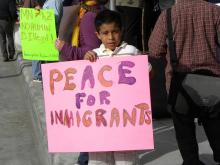
The study “highlights how policies can have effects far beyond, perhaps, the individuals that are targeted by those policies,” Samantha Artiga, director of Kaiser’s Disparities Policy Project and co-author of the study, said. “We really hear how those feelings of fear and uncertainty have impacts on their health.”

Last month, a 10-year-old undocumented girl who was traveling by ambulance to a hospital in Texas was stopped by Border Patrol agents who then trailed her to the hospital, guarded her during gallbladder surgery and then took her into custody. She was released 10 days later after a national outcry.
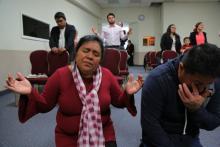
Even more difficult than the question of whether or not we are collectively willing to break the law is the question of whether we are ready to embody what a “culture of sanctuary” holistically invites us to be.
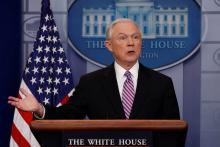
Attorney General Jeff Sessions threatened on March 27 to cut off U.S. Justice Department grants to cities that fail to assist federal immigration authorities, moving the Trump administration closer to a potential clash with leaders of America's largest urban centers.
Sessions' statements were aimed at a dozens of cities and other local governments, including New York, Los Angeles, and Chicago, that have joined a growing "sanctuary" movement aimed at shielding illegal immigrants from stepped-up deportation efforts.

The Trump administration’s hard-line stance on undocumented immigrants is polarizing: People have responded with either “throw the bums out” or “have a heart.” But the question of whether faith communities can legally offer the undocumented physical sanctuary — sheltering them in churches, synagogues, and mosques to keep them from immigration authorities — is not so cut and dry.

“Even if you’re not a Christian,” Leupold said, it should concern everyone “that we have moved to proto-fascist, race-based decision making.” As much as he sees Trump’s enthusiasm for deportation as a universal source of disquiet, Leupold said that Christians, in particular, should feel compelled to act in light of the Bible’s clear message: “Jesus said, ‘go out and love one another,’ he didn’t say, ‘go and seek racial purity in your community.” The parable of the Good Samaritan, he noted, didn’t include a section where “the Samaritan went up and checked the ID of the guy laying by the side of the road.”

More than 800 congregations have declared themselves sanctuaries for undocumented immigrants, about double the number since Election Day.
Leaders of the sanctuary movement say the pace of churches, and other houses of worship, declaring themselves sanctuaries has quickened, in the days leading up to the inauguration of President-elect Donald Trump on Jan. 20.
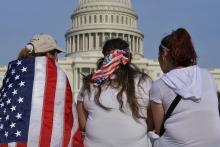
ON MAY 1, 1986, a federal jury found nine church activists guilty of conspiracy to violate U.S. immigration laws for assisting Central American refugees. At our sentencing, I faced a possible 25-year prison sentence.
The “sanctuary trial” drew national attention; millions of Americans learned about the plight of Central American refugees and the church-led sanctuary movement to aid them. After a seven-month trial and our conviction, the judge suspended our sentence and gave us five years of probation.
In the 1980s, our case hinged on the fact that we knew that those arriving over the southern border were refugees from brutal wars in Guatemala and El Salvador. I had worked in Guatemala and in Guatemalan camps in southern Mexican. We placed refugees in communities of faith where people met them as real people and learned why they had fled. We defied U.S. immigration laws in order to protect life. We also challenged the Reagan administration’s support of brutal regimes in Guatemala and El Salvador.
Today, most of the non-Mexican undocumented immigrants coming over the border are from Guatemala, El Salvador, and Honduras. Many are unaccompanied minors or single adults with children. Many have legitimate asylum cases, but don’t have adequate legal representation.
The new sanctuary movement is addressing four key areas: First, assisting migrants when they arrive with basic needs and legal help. Diocesan Migrant Refugee Services in El Paso, Texas, is the largest provider of “Know Your Rights” information to refugees, particularly those staying in community-run hospitality houses along the border. Without the assistance of volunteers, usually church-affiliated, migrants would be on their own—or worse, detained in for-profit prisons.

FOR CHRISTIANS who live near the U.S.-Mexico border, Jesus’ command to “love our neighbors as ourselves” takes on a particular urgency when we see our neighbors fleeing violence from their home countries and then being deported back at an alarming rate.
At Southside Presbyterian Church in Tucson, where I am pastor, we have a history of loving our neighbors by offering them protective sanctuary to shield them from deportation.
Sanctuary is an ancient biblical tradition. In Exodus, Numbers, Deuteronomy, Joshua, and 1 Kings, scriptures describe the right of asylum in cities of refuge set aside for those accused of manslaughter until the truth of the matter could be resolved. There is also the tradition of those who seek the safety of the temple by clinging to the “horns of the altar” (1 Kings 1:50).
In the U.S., churches involved in the abolitionist movement and the Underground Railroad provided sanctuary to escaping slaves. In the Vietnam War era, churches protected conscientious objectors. During the brutal wars in Central America in the 1980s, hundreds of U.S. churches declared a national sanctuary movement, protecting tens of thousands of refugees from being deported to almost certain death. Southside Presbyterian was one of the founding churches of the 1980s sanctuary movement.
In May 2014, after another wave of deportations, our congregation made a public declaration to once again become a sanctuary church. We welcomed Daniel Ruiz, a local undocumented father, into protection. After 28 days living in the church, he received a stay of deportation.

Rosa Robles spent 461 days inside a Tucson, Ariz., church after receiving a deportation order that would have separated her from her husband and children.
She has finally received an assurance from the federal government that she will not be deported, so on Nov. 11, she left the church for the first time in over one year.

Think about this: why would anyone travel thousands of miles on a journey that many do not survive — except for the hope that their destination (the U.S.) is significantly safer than where they currently live? I cannot imagine taking such risks unless my current circumstances left me with no other options besides death. I have met many people who are undocumented in the U.S. They are not criminals. They are not economic threats. They are mothers and fathers, aunts and uncles, and sometimes teenagers trying to escape untold violence and oppression. They are our neighbors, community members, and friends. They are people simply trying to do what it takes to survive.
Our immigration system is broken. It is hard for anyone to say otherwise. But I think our values are broken too. When gun-toting vigilantes are able to successfully threaten buses full of children put at risk by their parents because it was a better option than staying at home, something is desperately wrong with our values. We can say their home country needs to get its act together, but that does not address the hostile response in the U.S. by some people. Politics aside, the morality of refusing such people violates the values of both my Christian faith and my understanding of how my country was founded by persecuted refugees seeking freedom.
Comprehensive immigration reform is about real people with real blood flowing through real veins. It is not about numbers, other than the fact that the U.S. grants the lowest number of visas to the countries with some of highest homicide rates in the world — violence that the U.S. government has had a hand in creating over the past several decades. This is not about following the law, because our current immigration laws are simply unjust and violate the values upon which this country was founded: a country of immigrants in which “all people are created equal.” It is about God’s children desperately seeking refuge in a country that boasts itself as the “land of the free” and the land of hope and promise.
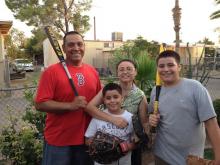
On Aug. 7 we lit a single white candle at the prayer service welcoming Rosa Robles Loreto into sanctuary at Southside Presbyterian Church in Tucson, Ariz. Almost 90 days later, that candle has been joined by five others, representing Luis Lopez Acabal, Beatriz Santiago Ramirez, Francisco Aguirre, Francisco Perez Cordova, and Arturo Hernandez. We are grateful that Beatriz was just granted a stay so that she could return to her home with her two small children, but the rest all remain in sanctuary.
As we approach Rosa’s 90th day in sanctuary, its time to replace the nearly burned down candle, but the light of radical Christian hospitality continues to not only burn bright, but spread throughout the nation.

On Sept. 25 Francisco Córdoba entered into Sanctuary at St. Francis in the Foothills United Methodist Church in Tucson, Ariz., after the threat of deportation had been looming over his family's life for eight long months.
It has been an honor for those of us here at St. Francis to receive the blessing of Francisco and his family and to offer them a place where they can begin to see a solution to our broken immigration system. It was even more important that we receive the amazing blessing that they bring to us.

Unknown to most, sanctuary is actually one of the most ancient traditions we have as a people of faith. In the late Roman Empire, fugitives found refuge in early Christian churches; in medieval England, churches protected accused wrongdoers; and in the years before the Civil War, people of faith organized the Underground Railroad to help slaves flee the South. In the 1980s, nearly 500 congregations practiced sanctuary in an attempt to shelter the hundreds of Central Americans fleeing brutal violence in Guatemala and El Salvador.
Currently, the Sanctuary Movement allows members of congregations who are facing deportation to reside within the sacred space of a church, synagogue, or mosque in order to avoid immediate deportation from the Immigration and Customs Enforcement (ICE) agency. Although the ICE is not legally banned from entering churches or schools, custom is to avoid such sensitive areas unless a suspected terrorist or dangerous felon is involved.
Today there are currently 5 active sanctuary cases, along with 30 congregations who are offering sanctuary in Arizona, Colorado, Illinois, Washington, Maine, and Oregon. The Sanctuary Movement is important because it breaks down the polarized, politicized, and dehumanized aspects of immigration reform and looks instead to Christ as a model for loving one’s neighbor.
Ruth Nettles put down her knitting to listen to a young Salvadoran refugee who said he had fled his home in El Salvador in 1981 at the age of 16 after four family members had been shot to death. He had come to the United States hoping to find a life free from terror and fear. Instead, he was testifying as a government witness in the trial of the very people who had helped him.
"I ran out of the courtroom and went to the bathroom and just cried," Ruth says of the experience.
It was such compassion and heartfelt emotion that brought Ruth, 60, and her 63-year-old husband, Kenneth, to the sanctuary trial, and kept them there. Last December, while passing through Tucson on a vacation from their Florida home--pulling their Airstream trailer behind a white Suburban--they stopped in the federal courthouse to see a bit of the sanctuary trial they had heard so much about. After their second morning in the courtroom, they decided to put their vacation on hold and stay until the end of the trial.
Kenneth Nettles is a Southern Baptist preacher who retired from the Air Force with the rank of major after 20 years as a chaplain. His tour of duty as the chaplain for a bomb squad and at an evacuation hospital, where he saw the mutilated bodies of young men, made Nettles begin to question the role of his government. Years later he began to read about Central America and U.S. involvement there. He had seen it all before. "I felt that if the U.S. persisted, it would be another Vietnam debacle."
At the time of the interview, Peggy Hutchison was a United Methodist, director of border ministry for the Tucson Metropolitan Ministry, a graduate student in Middle East Studies at the University of Arizona and married to Michael Eisner. —The Editors
Sojourners: What kind of experience has the trial been for you?
Peggy Hutchison: For me it's been like a tragedy and a comedy. There are times when I've laughed so hard I'd cry. And there are times when I have literally cried. Probably the most painful part has been sitting there silently while the refugees have to testify. They are robbed of all their emotions, all of their humanity. They aren't given any dignity and respect. And we had to just sit there silently and not say anything. That was very painful.
I don't like being there. I didn't choose it; none of us did. And though we're 11 defendants, we're very different—theologically and politically. The one thing we have in common is our concern about refugees. The government brought us together, and that's been difficult, to be honest with you. But it's been a blessing, and I think we've learned from it.
Some of the things that we've struggled with for many years working in sanctuary are the same things we continue to struggle with in the context of the courtroom. Through this trial experience, I've relearned the importance of interpersonal relationships. I think that those of us in sanctuary, as well as other movements of the church or of the religious community, have tried to be there with each other when one of us has fallen on the sidelines. We have tried to be present with each other along this struggle.

So justice is driven back, and righteousness stands at a distance; truth has stumbled in the streets, honesty cannot enter. Truth is nowhere to be found, and whoever shuns evil becomes a prey. --Isaiah 59:14-15